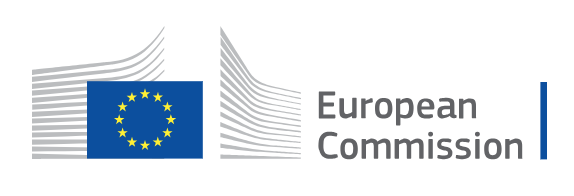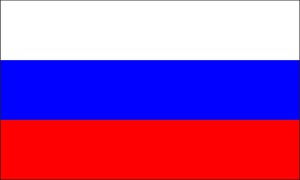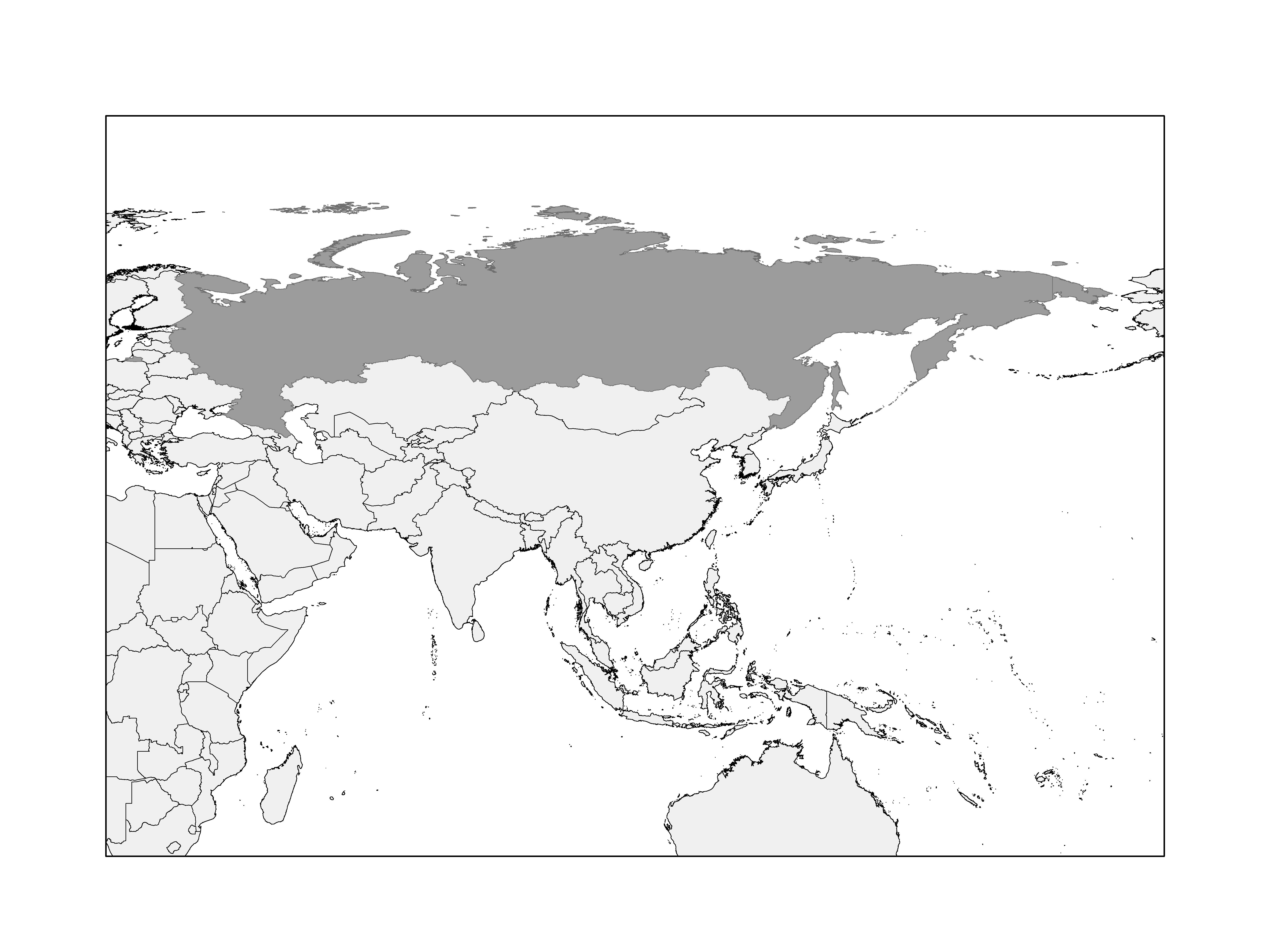ECONOMIC VALUE OF FOREST SECTOR:
USD 13.08 billion in 2011⁶
0.8% of the GDP in 2011⁶
2nd highest exporter of EUTR products in 2015 by weight (kg)⁷
13th highest exporter of EUTR products in 2015 by value (USD)⁷
ANNUAL DEFORESTATION RATE:
5.3 million hectares of tree cover lost in 2017⁸
Average of 4.43 million hectares per year 2013-2017⁸
CERTIFIED FORESTS:
FSC certification: 46.2 million hectares (2018)⁹
PEFC certification: 12.9 million hectares (2017)¹⁰
FSC & PEFC certification: 8.96 million hectares (2017)¹¹
CHAIN OF CUSTODY CERTIFICATION:
FSC certification: 497 CoC certificates (2018)⁹
PEFC certification: 30 (2017)¹⁰
MAIN TIMBER SPECIES IN TRADE:
Hinggan fir (Abies nephrolepis), birch (Betula spp.), European beech (Fagus sylvatica), ash (Fraxinus spp.), larch (Larix spp.), spruce (Picea spp.), pine (Pinus spp.), oak (Quercus spp.), lime (Tilia spp.) and elm (Ulmus spp.)¹²
CITES-LISTED TIMBER SPECIES:
4 species: Taxus cuspidata (Appendix II), Fraxinus mandshurica, Pinus koraiensis and Quercus mongolica (Appendix III)¹³
RANKINGS IN GLOBAL FREEDOM AND STABILITY INDICES:
Rule of law index¹⁴
4th quarter
89/113 in 2017
Corruption perception index¹⁵
3rd quarter (score: 29)
135/180 in 2017
Fragile states index¹⁶
3rd quarter
69/178 in 2018
(Inverse scoring system)
Freedom in the world index¹⁷
4th quarter
69/83 in 2018
KEY RISKS FOR ILLEGALITY
In 2015, the Russian Federation exported EUTR-regulated products to 118 countries and territories, totalling 41.04 billion kg7, of which 26.7% was exported to the EU-28 by weight and 34% by value. China imported the largest proportion of EUTR products by value (Figure 1a) Exports of EUTR products mainly consisted of sawn wood (HS4407*) by both weight and value (Figures 1b and 1c). Paper products (HS48) account for the second greatest proportion of the value of exports, while rough wood (HS4403) was the next most exported product by weight, indicating the higher relative value of paper products. The Russian Federation imported very low volumes of wood products relative to its production in 2014, and consumed most of its wood domestically (Table 1). The majority of EUTR-regulated products imported into the EU from the Russian Federation in 2015 were imported by Finland and Germany, followed by Italy and the United Kingdom (by value; Figure 2) and the Netherlands and Sweden (by weight; Figure 3).
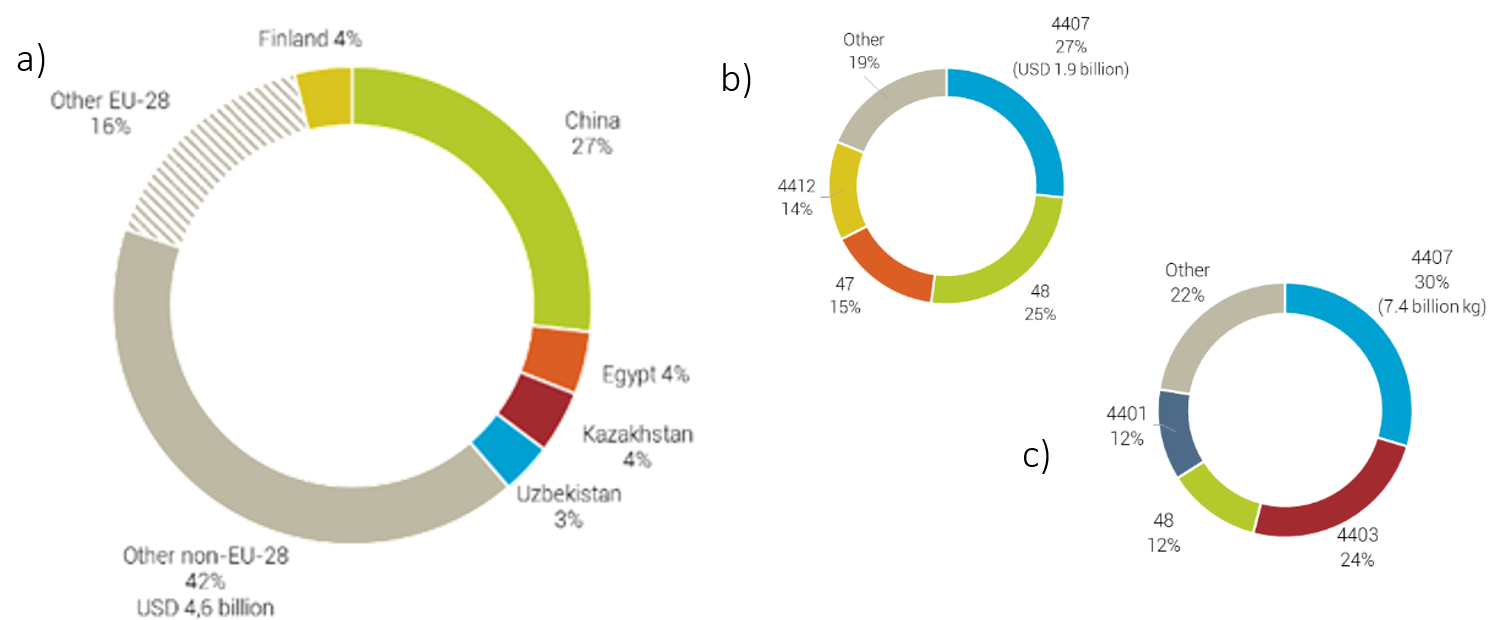
Figure 1: a) Main global markets for EUTR products from the Russian Federation in 2015 in USD; b) main EUTR products by HS code exported from the Russian Federation by value in USD in 2015; and c) main EUTR products by HS code exported from the Russian Federation by weight (kg) in 2015. Produced using the Russian Federation reported data from UN COMTRADE7.
Table 1: Production and trade flows of main timber products in the Russian Federation in 201512.
| Production (x 1000 m³) |
Imports (x 1000 m³) |
Domestic consumption (x 1000 m³) |
Exports (x 1000 m³) |
|
| Logs (industrial roundwood) | 203 000 | 19 | 181 968 | 21 051 |
| Sawnwood | 33 900 | 37 | 11 350 | 22 587 |
| Veneer | 690 | 18 | 322 | 386 |
| Plywood | 3513 | 244 | 1851 | 1906 |
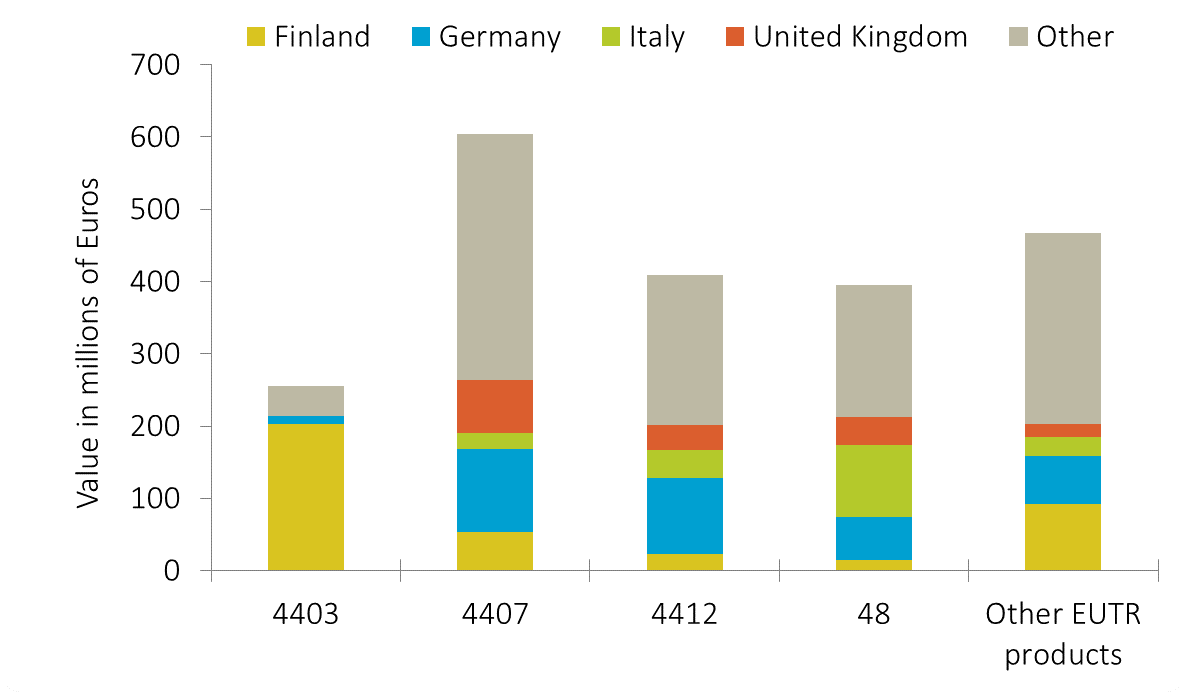
Figure 2: Value of EU imports of EUTR products from the Russian Federation to the EU in 2015 by HS code. Producing using data from EUROSTAT18.
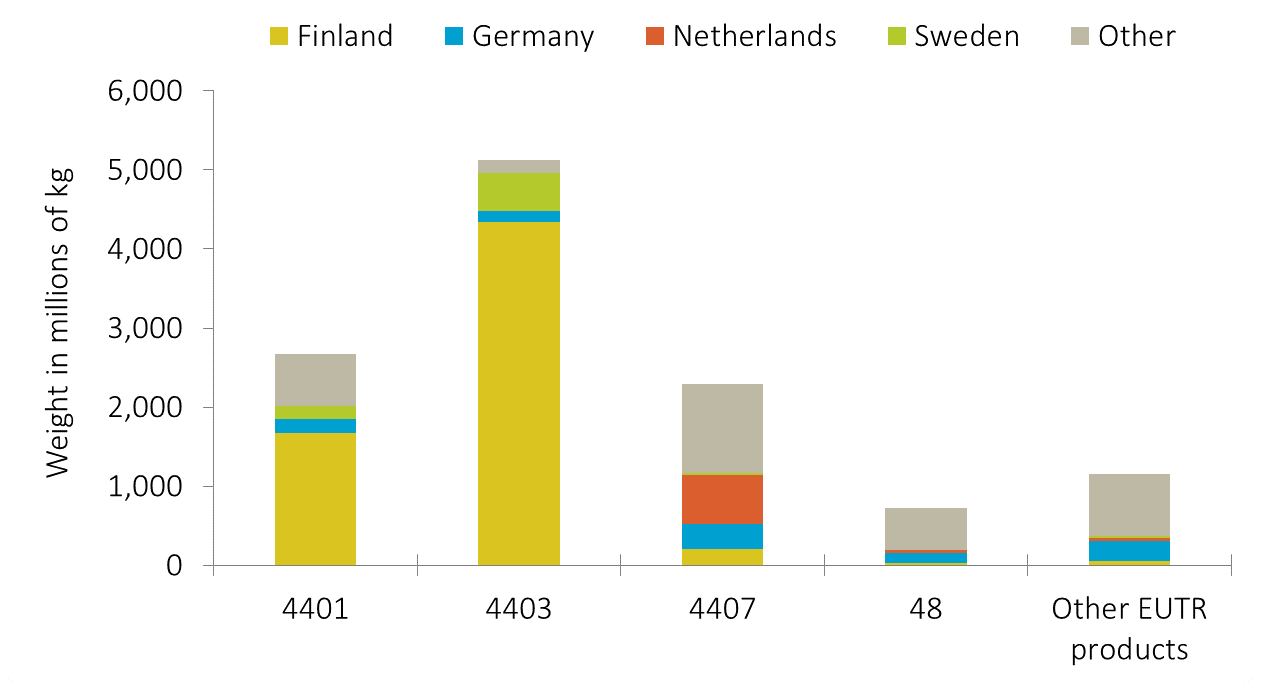
Figure 3: Quantity of EU imports of EUTR products from the Russian Federation to the EU in 2015 by HS code. Producing using data from EUROSTAT18.
*Key to HS codes: 4401 = fuel wood; 4403 = rough wood; 4407 = sawn wood; 4412 = plywood and veneered panels; 47 = wood pulp; 48 = paper and paper products
LEGAL TRADE FLOWS
COMPLIANCE WITH LEGISLATION:
Legislation is often complied with on paper, but most illegal logging seems to occur through misuse of permits issued, such as sanitary logging permits19–22 and overharvesting relative to permits issued20.
BRIBERY INCIDENCE:
14.2% of firms experiencing at least one bribe payment request in 201223.
Based on data collected on behalf of the World Bank across a range of sectors.
ILLEGAL HARVESTING OF SPECIFIC TREE SPECIES:
Caucasus: oak, chestnut, beech21
Southeast Siberia: Scots pine21
Russian Far East: Mongolian oak (Quercus mongolica), Manchurian ash (Fraxinus mandshurica), Japanese elm (Ulmus propinqua), Amur linden (Tilia amurensis) and Manchurian linden (Tilia mandshurica)20,24
PREVALENCE OF ILLEGAL HARVESTING OF TIMBER:
Estimated 20% of logging nationwide24.
Estimated 80% in the Russian Far East in 201319.
RESTRICTIONS ON TIMBER TRADE
The Russian Federation does not currently have any export bans in place for timber25, but a temporary restriction can be imposed on the export of birch logs larger than 15cm in diameter and longer than 1m26. Harvest is prohibited for some species27; a ban on the logging of Korean pine (Pinus koraiensis) was announced in November 201028.
There is an EU ban on import of goods from Crimea and Sevastopol29,30.
COMPLEXITY OF THE SUPPLY CHAIN
Potentially very complex in the Russian Far East: harvested timber can be processed at local or regional sawmills, with raw or processed timber mainly exported to China19; timber from other sources can be added throughout the supply chain, which is potentially not declared upon export19.
Illegal trade
According to figures from the Russian Federal Forestry Agency (Roslezhoz) as reported by GRID-Arendal, between <1% and 10% of the total wood harvest is illegally cut every year31; however, estimates from different sources range from 10% up to 60%31. The Office of the President of the Russian Federation also reported an approximate 66% increase in illegal logging from 2008 to 2013 in the Russian Federation32. Illegal commercial logging was reported to be concentrated primarily along boarder regions, as high quality timber is in demand from foreign buyers31. In 2014, there were 18 400 reported cases of illegal logging of forest plantations, totalling a volume of 1 308 400 m³, equating to 10.8 billion rubles31. The most critical areas of illegal harvesting were reported to be Siberia and the Russian Far East (RFE)31, where up to 80% of precious hardwood cut was estimated to have been harvested illegally in 201319. The Primorsky Krai region of the RFE was reported to account for two thirds of the illegal logging in the RFE31. In a 2014 survey of 100 timber companies in the Russian Federation, 13% of respondents overall and 66% of respondents in the RFE (4 respondents) were unsure whether products they sold to EU markets were completely legal33. Major contributing factors reported for the prevalence of illegal logging included high levels of corruption, organised crime in the forest industry and lack of law enforcement and ineffective legislation31.
China imports over 95% of the valuable hardwoods exported from the RFE19. Logs and sawnwood from the Russian Federation are the main source of China’s wood and paper imports and bear a high risk of illegality34. Volumes of Mongolian oak logged in the Russian Federation for export to China exceeded the authorised logging volumes 2004-2011 by two to four times22. Due to China’s role as the largest wood processing country globally35, illegal Russian timber is likely re-exported as wood products, potentially mixed with timber from other sources19. For example, the largest US Lacey Act fine to date was for timber illegally logged in the RFE and imported to the United States via China36. Chinese owned sawmills operating in the Russian Federation have also been noted to operate illegally, through use of falsified documents and bribes19,22. The links between Russian illegal timber, Chinese importers and processors and the global market have been investigated in a number of Environmental Investigation Agency (EIA) reports and others37,38,19,20,31. Illegal timber for the Chinese market is reportedly typically obtained from legal concessions beyond the agreed quota, from places where harvesting is forbidden or harvested under the false claims of sanitary felling or thinning31. Methods reportedly used to launder illegally harvested timber for export to China are based around the provision and utilisation of false documentation or poor declaration and traceability31.
Illegal logging in the Russian Federation, especially in the RFE, has been reported to be carried out via bribes19, establishment of temporary trading companies which act as intermediaries between illegal loggers and international exporters19, misuse of sanitary and “intermediate” logging permits to harvest healthy trees19–22, falsified permits and overharvesting relative to permits20 and harvesting in protected areas20,22,39. Reductions in the funding to forest enforcement is likely to have impacted the effectiveness of patrol based enforcement19,20,22; prosecution rates are also low22.
In a 2017 risk assessment of timber legality in the Russian Federation, NEPCon identified a wide range of key risks including: involvement of corruption in the issuance of concession licences and during the approval of Forest Declarations and Technological Maps; tax evasion – including companies set up for a short period of time solely for tax avoidance; harvest of timber ouside official boundaries or in excess of approved harvest volumes; harvest of unauthorised species; illegal export of CITES species with unknown/unclear origin; and issues of transfer pricing40. In addition, there were key risks relating to workers being employed unofficially, the use of non-registered immigrant labour, and rights of third parties40. The risk assessment includes suggested control measures and verifiers for risk mitigation.
Forestry management and legislation
In 2013, the Russian Federation introduced an eight year plan, “The Development of Forestry 2013-2020”, aiming to reduce illegal logging and increase profits from the timber sector41; the Criminal Code was also updated in 2014 to include stricter penalties for illegal logging, transport and sale42. Timber labelling, traceability and monitoring system requirements were updated in the 2013 Federal Law “On Amendments to the Forest Code of the Russian Federation”43. A new electronic system for recording timber related information, the Uniform State Automated Information System (EGAIS), was launched 1 January 201531,42. All organisations dealing in timber are required to submit information on the volume of timber harvested, labels used and timber sold42. Forests are state owned and licences to harvest are issued to companies or individuals27. The Russian Federation also maintains a list of tree and shrub species for which harvest is prohibited8.
Approximately 38% of the total export volume from the Russian Federation in 2013 was reported to be from certified sources44; however, certified sources do not contain many valuable hardwoods44. A 2016 risk assessment for the Russian Federation by the FSC also considered there to be “specified risk” (certain risk that material from unacceptable sources may be sourced or enter the supply chain) for illegally harvested wood45.
A 2014 survey of forestry sector company employees in the Russian Federation found that 94% were aware of EUTR, although 53% were not aware of some of EUTR requirements33. Companies in the RFE were the least informed of those surveyed33.
| RELEVANT LEGISLATION AND POLICY[1] | ||
| For further details on the Russian Federation’s legislation relevant to EUTR, see the Federal Agency of Forestry website, the Russian Federation country page on FAOLEX and NEPCon (2017) ‘Timber legality risk assessment’. | ||
| The Forest Code of the Russian Federation No. 200-FZ of 4 December 2006 (and its amendments)
The Russian Roundwood Act 415-FZ (2013) Order no. 1 of the Federal Forestry Agency (2012) |
Order no 47 of the Federal Forestry Agency (2012)
Regional Law no. 132-PK, 2013 Regional Law no. 12-ZKO “On delimitation of plenary powers between state bodies in the sphere of forest relations” (2011) |
|
| LEGALLY REQUIRED DOCUMENTS[2] | ||
| See NEPCon (2017) ‘Timber legality risk assessment’ and WWF’s ‘Keep it legal’27 for a further list of legally required documents. | ||
For logging:
For transport:
Forests stands sale agreement/Forest declaration (for transport by rail) |
For domestic market processing/sale:
Export:
|
|
[1] The following list may not be exhaustive and is intended as a guide only on relevant legislation.
[2] The following list may not be exhaustive and is intended as a guide only on required documents.
References
- FAO. FAO Country Profiles: Russia Federation. (2018). Available at: http://www.fao.org/countryprofiles/index/en/?iso3=RUS. (Accessed: 13th August 2018)
- FAO. Global Forest Resources Assessment 2015. Desk reference. (Food and Agriculture Organization of the United Nations, 2015).
- Rights and Resources Initiative. Tenure data tool. (2018). Available at: https://rightsandresources.org/en/work-impact/tenure-data-tool/#.WjjlOVVl9ph. (Accessed: 2nd July 2018)
- UNEP-WCMC. Protected Area Profile for the Russian Federation from the World Database of Protected Areas, January 2018. (2018). Available at: https://www.protectedplanet.net/country/RU.
- EU FLEGT Facility. VPA countries. (2018). Available at: http://www.euflegt.efi.int/vpa-countries. (Accessed: 2nd July 2018)
- FAO. Contribution of the forestry sector to national economies, 1990-2011, by A. Lebedys and Y. Li. Forest Finance Working Paper FSFM/ACC/09 (Food and Agricultural Organization of the United Nations, 2014).
- United Nations Statistics Division. UN Comtrade Database. (2017). Available at: https://comtrade.un.org/data/.
- Global Forest Watch. Russia Country Profile. (2018). Available at: http://www.globalforestwatch.org/country/RUS. (Accessed: 2nd July 2018)
- FSC. Facts and figures August 2018. (Forest Stewardship Council, 2018).
- PEFC. PEFC Gobal Statistics: SFM & CoC Certification. (2017).
- FSC & PEFC. Estimated total global double certified area FSC/PEFC. (FSC and PEFC, 2017).
- European Timber Trade Federation. Country profile Russia. (2018). Available at: http://www.timbertradeportal.com/countries/russia/. (Accessed: 2nd July 2018)
- UNEP-WCMC. The Species+ Website. Nairobi, Kenya. Compiled by UNEP-WCMC, Cambridge, UK. (2018). Available at: https://speciesplus.net/. (Accessed: 2nd July 2018)
- World Justice Project. Rule of Law Index 2017-2018. (2018). Available at: http://data.worldjusticeproject.org/. (Accessed: 2nd July 2018)
- Transparency International. Corruption Perceptions Index 2017. (2018). Available at: https://www.transparency.org/news/feature/corruption_perceptions_index_2017. (Accessed: 2nd July 2018)
- Fund for Peace. Fragile States Index 2018. (2018). Available at: http://fundforpeace.org/fsi/. (Accessed: 2nd July 2018)
- Freedom House. Freedom in the World. (2018). Available at: https://freedomhouse.org/report/freedom-world-2018-table-country-scores. (Accessed: 2nd July 2018)
- European Commission. Eurostat. (2017). Available at: http://ec.europa.eu/eurostat/data/database. (Accessed: 12th December 2017)
- EIA. Liquidating the forests: hardwood flooring, organised crime and the World’s last Siberian tigers. (EIA, 2013).
- EIA. The open door: Japan’s continuing failure to prevent imports of illegal Russian timber. (EIA, 2013).
- Milakovsky, B. Illegality risk in sourcing from Russia and Ukraine. (WWF, 2016).
- Smirnov (ed.), D. Y., Kabanets, A. G., Milakovsky, B. J., Lepeshkin, E. A. & Sychikov, D. V. Illegal logging in the Russian Far East: global demand and taiga destruction. (WWF Russia, 2013).
- The World Bank. Bribery incidence (% of firms experiencing at least one bribe payment request). (2017). Available at: https://data.worldbank.org/indicator/IC.FRM.BRIB.ZS.
- Gan, J. et al. Quantifying Illegal Logging and Related Timber Trade. in Illegal Logging and Related Timber Trade – Dimensions, Drivers, Impacts and Responses. A Global Scientific Rapid Response Assessment Report (eds. Kleinschmit, D., Mansourian, S., Wildburger, C. & Purret, A.) 37–59 (IUFRO, 2016).
- Forest Legality Initiative. Logging and export bans. (2017). Available at: http://www.forestlegality.org/content/logging-and-export-bans. (Accessed: 26th April 2017)
- Governement of the Russian Federation. Decree of the Government of the Russian Federation No. 19 of January 18, 2017 “On Amendments to the List of Goods that are Materially Important for the Internal Market of the Russian Federation, for which, in exceptional cases, temporary export restrictio. (Government of the Russian Federation, 2017).
- WWF-Russia. Keep it Legal Country Guide Russia: Practical guide for verifying timber origin legality. (WWF-Russia, 2010).
- Thomas, P. & Farjon, A. Pinus koraiensis. The IUCN Red List of Threatened Species. (2013). Available at: http://www.iucnredlist.org/details/42373/0. (Accessed: 30th January 2018)
- European Commission. European Union Restrictive measures (sanctions) in force. (European Commission, 2017).
- European Commission. EU sanctions on Russia. (EU Sanctions Map, 2018).
- Fedorov, A., Babko, A., Sukharenko, A. & Emelin, V. Illegal logging and the illegal trade in forest and timber products. GRID Arendal (2017). doi:10.1505/IFOR.5.3.195.19148
- The Office of the President of Russia. Meeting of the Presidium of the State Council on increasing the efficiency of the forest complex. (2013). Available at: http://kremlin.ru/events/president/news/17876. (Accessed: 11th January 2018)
- Shmatkov, N., Karaeva, O., Shegolev, A. & Verin, R. Results of the survey of Russian forest industry senior staff awareness of the European Union Timber Regulation 995/2010. (WWF, 2015).
- Hoare, A. Tackling illegal logging and the related trade: what progress and where next? (Chatham House, 2015).
- Kleinschmit, D., Mansourian, S., Wildburger, C. & Purret, A. (eds). Illegal logging and related timber trade – dimensions, drivers, impacts and responses. A global scientific rapid response assessment report. (IUFRO, 2016).
- The United States Department of Justice. Lumber Liquidators Inc. sentenced for illegal importation of hardwood and related environmental crimes. (2016). Available at: https://www.justice.gov/opa/pr/lumber-liquidators-inc-sentenced-illegal-importation-hardwood-and-related-environmental. (Accessed: 29th May 2017)
- EIA. No questions asked: the impacts of US market demand for illegal timber – and the potential for change. (EIA, 2007).
- EIA. Appetite for destruction: China’s trade in illegal timber. (EIA, 2012).
- Shmatkov, N. EU Timber Regulation and Round Wood Act of the Russian Federation. (WWF Russia, 2014).
- NEPCon. Timber legality risk assessment: Russia. (2017).
- Government of the Russian Federation. State programme: Forestry Sector Development, 2013-2020. (2013). Available at: http://government.ru/en/docs/3354/. (Accessed: 29th May 2017)
- Cashore, B., Leipold, S. & Cerutti, P. Global governance approaches to addressing illegal logging: uptake and lessons learnt. in Illegal Logging and Related Timber Trade – Dimensions, Drivers, Impacts and Responses. A Global Scientific Rapid Response Assessment Report 119–132 (IUFRO, 2016).
- Rossiyskaya Gazeta. Federal Law No. 415-FZ of December 28, 2013 ‘On Amendments to the Forest Code of the Russian Federation and the Code of the Russian Federation on Administrative Offenses’. Rossiyskaya Gazeta – Federal Issue No.6271 (295) (2013). Available at: https://rg.ru/2013/12/30/drevesina-dok.html. (Accessed: 11th January 2018)
- Milakovsky, B. Illegality risks and due care for wood flows from the Russian Far East. (WWF Russia, 2015).
- FSC Russia. FSC National Risk Assessment for the Russian Federation. (FSC, 2016).
